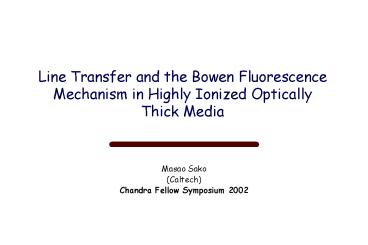Line Transfer and the Bowen Fluorescence Mechanism in Highly Ionized Optically Thick Media PowerPoint PPT Presentation
1 / 13
Title: Line Transfer and the Bowen Fluorescence Mechanism in Highly Ionized Optically Thick Media
1
Line Transfer and the Bowen Fluorescence
Mechanism in Highly Ionized Optically Thick Media
- Masao Sako
- (Caltech)
- Chandra Fellow Symposium 2002
2
Brief Outline
- Radiative transfer effects
- Motivation
- Detailed treatment generally ignored in global
modeling (e.g., in XSTAR, Cloudy, etc.) - How do they affect the global emergent spectrum?
- Theory of resonance line scattering
- Line production/destruction mechanisms
- Line overlap and the Bowen fluorescence mechanism
- He II / O III in the UV (classical Bowen
fluorescence) - O VIII / N VII in the X-ray
- Simple spectral model
3
Radiative Transfer Effects
- Transfer effects are important when ? gt 1
- There are three important levels of opacity
sources - Line absorption/scattering (? 10-16 cm2)
- Continuum absorption (? 10-18 cm2)
- Electron scattering (? 10-24 cm2)
- Most codes assume complete redistribution /
escape probability methods for treating resonance
line transfer - Although this approximation is appropriate for
isolated lines with moderate optical depths (?
10), it does not adequately describe line
transfer when absorption and scattering in the
damping wings become non-negligible (i.e., when ?
? 100 - 1000). - It is also difficult to apply this method when
other opacity sources (e.g. continuum absorption,
line overlap) are important as well. - In this formalism, a correct treatment of
radiative transfer is nearly hopeless when there
are abundance and temperature gradients.
4
Theory of Line Transfer
- Has been worked out by various authors
- Unno (1952, 1955) Hummer (1962) Auer (1967)
Weymann Williams (1969) Ivanov (1970, 1973)
Hummer Kunasz (1980) - Problem
- Solve for the intensity given by the following
transfer equation
Continuum opacity
Line source function
Intensity
Line profile
Line optical depth
5
Theory of Line Transfer
- The source function contains intrinsic as well as
scattering terms. - obtain solution by rewriting the transfer
equation as a second order differential equation,
and discretizing the spatial (optical depth),
angle, and frequency coordinates - Feautrier
(1964) method
destruction probability
intrinsic source distribution (e.g.,
recombination collisional excitation)
redistribution function
6
Single-Ion Line Ratios
- H-like oxygen at kT 10 eV (weakly temperature
dependent) - When higher order Lyman lines are absorbed, there
is a 80 chance (depending on the principal
quantum number) for the line to be re-emitted.
The other 20 of the time, the line is radiated
in the Balmer, Paschen, etc. lines, and
eventually as either a lower-order Lyman line or
2-photon emission from the 2s level.
7
Bowen Fluorescence Mechanism
- Classic He II / O III Bowen fluorescence (Bowen
1934,1935 Weymann Williams 1969)
8
O VIII / N VII Transfer
- O VIII Ly-alpha N VII Ly-zeta (n7) wavelength
overlap
9
O VIII / N VII Transfer
- Line photons scatter around in space and
frequency. Every once in a while, an O VIII line
photon scatters with N VII. When this happens,
the line is lost 20 of the time. - The N VII line intrinsic
source
function is
negligible compared to
that of the O VIII
lines. Makes very little
difference to the final
results. - Partial redistribution in
a Voigt profile is
assumed for all the
lines.
10
Conversion Efficiencies
- From the solution to the transfer equation, one
can calculate the efficiencies for the various
processes. In the previous case, the lines
either - scatter and eventually escape the medium through
the boundaries - absorbed by the underlying continuum
- absorbed by N VII, followed by cascades to the
upper levels
11
Emergent O VIII / N VII Spectrum
- A hypothetical medium containing
only O VIII, N
VII, and some
unspecified form of
background
continuum (? 10-5).
An abundance
ratio of O/N 5 is assumed. - At ? 100, the higher-order lines
are almost completely suppressed,
while
the Ly? lines are still
unaffected. - At ? 1000, fluorescence
scattering is
important, and some
of the O VIII
Ly? lines are
converted to the N VII
Lyman,
Balmer, etc. lines.
33 of this
radiation escape as Ly?
photons. - At ? 104, most of the O VIII
Ly? line is destroyed
12
A Few Other Important Line Overlap
- Fe XVIII - O VIII Ly?
- the Fe XVIII source function dominates over that
of O VIII - the line separation is quite large important for
large turbulent velocity.
- Fe XVII - O VII Ly-n (n gt 5)
- similar to the previous case - the Fe XVII source
function dominates. multiple levels of O VII
contribute to the total opacity.
13
Summary, Conclusions, Future Work
- Line transfer effects can alter not only line
ratios within a given ion, but also across
different elements. - Important for deriving CNO abundances from
optically thick sources (e.g., in accretion
disks). - Work in progress.
- Incorporate Compton scattering.
- Important in very highly ionized medium where the
metal abundances are extremely low, i.e., when AZ
? ?b-f ?T. - Comprehensive / global spectral modeling
including all important metal transitions. - e.g., Fe XIX - XXIV lines with O VIII continuum
(? lt 14.2 Å) - relativistic effects

